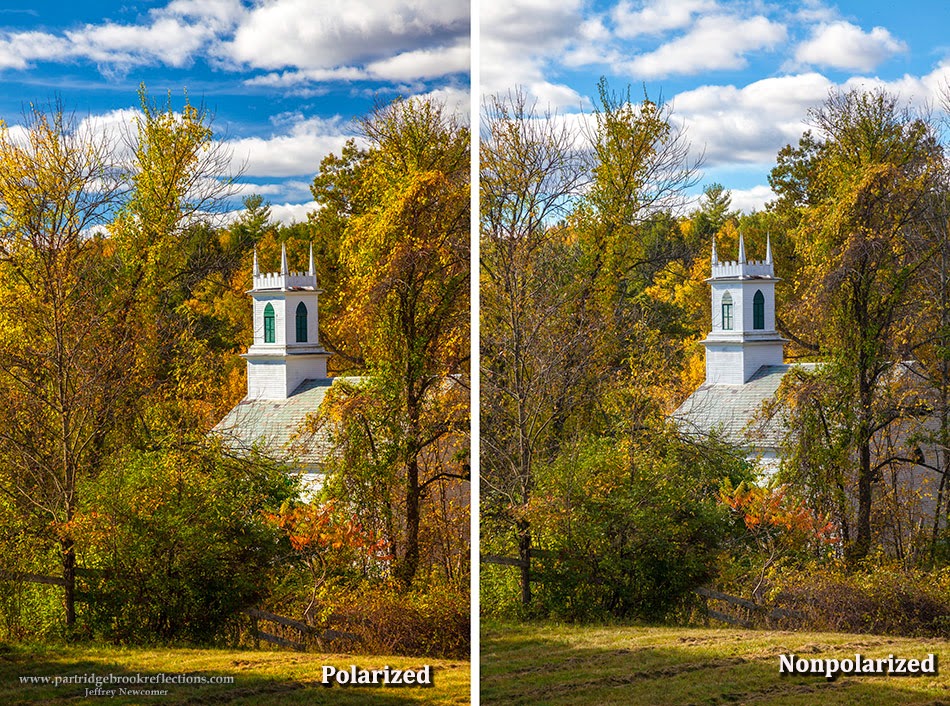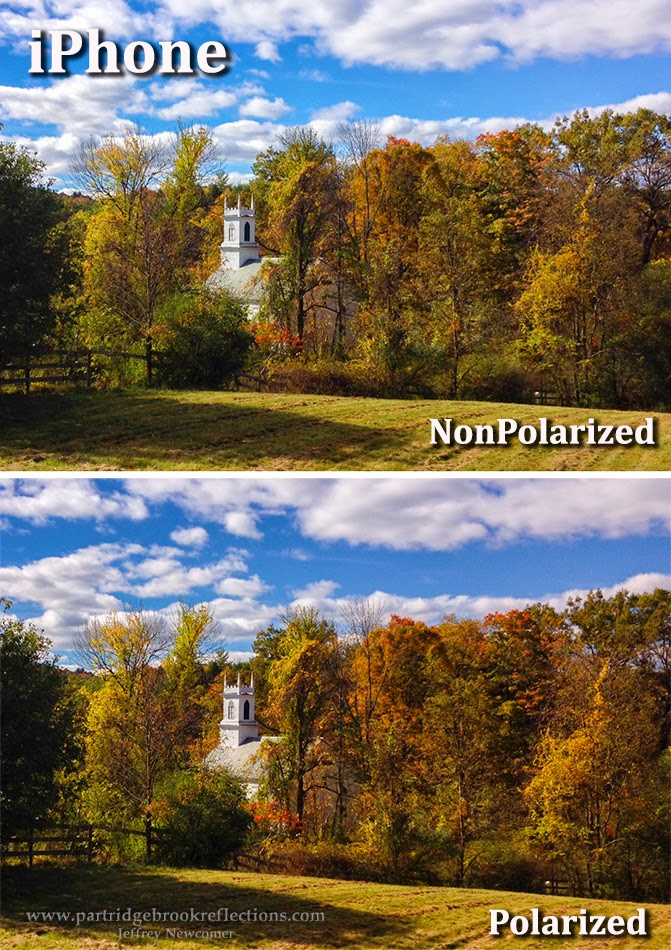It has been a lovely Columbus Day fall foliage weekend. In this weeks blog, I have already whined about being stuck at home entertaining autumn peepers in my studio while the color outside has been peaking. I feel a bit guilty, not only about the whining, but also about posting before my usual Sunday time-frame. The Studio Tour has been a success. I saw a steady stream of visitors and actually sold some pieces. Most enjoyably, I got to spend two whole days showing and talking to folks about my work. As partial atonement for my whining, I'm doing a short bonus blog about the one essential piece of gear for fall foliage shooting, the polarizing filter.
For many of my readers, the importance of a polarizing filter will go without saying. In the past I have discussed the use of a polarizer to enhance leaf photography, but this week I was reminded of the fact that the most important lessons can always
 |
| After I escaped from the "Studio" |
For the Rest of You
A polarizer is designed to cut through reflection and is the landscape photographer's most essential filter. Direct sunlight reflecting off most surfaces becomes polarized to a specific angle which can be filtered by rotating the polarizer to block that angle. The degree to which a polarizer can filter out the glare is related to the direction of the light, being most effective when it is at 90 degrees to the subject. On the other hand, when the light is coming from behind or in front of the camera, the effect is essentially nonexistent. The filter is great for darkening skies, seeing beyond reflection into the depths of lakes and streams, but for fall foliage, its most significant effect is to improve the color saturation of the leaves. It is often noted that the ability of a polarizer to block reflection is one of the few filter effects that can not be duplicated by digital editing and it is for that reason that it is considered THE essential filter and it is why my polarizer stays on the camera for most of the autumn.
 Examples are Best
Examples are BestI've included a few examples of polarization effect. The first is of brilliant red leaves by a cemetery in Harrisville, NH. The light reflected off the leaves mutes the colors, but the polarizer cuts through much of the reflection freeing the rich color to shine through. The same effect can be seen in the pictures of the First Universalist Church in West Chesterfield. Compare the color in the leaves and the reflections in
 the church spire. Both images were processed identically in Lightroom and Photoshop. A number of my students in the Keene State course use point and shoot cameras with no way to screw on a Polarizer, but I was able to show them that they could get a small filter, just a bit bigger than their lens, and hold it in front of the lens. The LCD display can be used to judge the optimal effect. I tried this with my iPhone. The difference was not as impressive, but I suspect it would be more noticeable with a filter that is better sized to tiny iPhone lens.
the church spire. Both images were processed identically in Lightroom and Photoshop. A number of my students in the Keene State course use point and shoot cameras with no way to screw on a Polarizer, but I was able to show them that they could get a small filter, just a bit bigger than their lens, and hold it in front of the lens. The LCD display can be used to judge the optimal effect. I tried this with my iPhone. The difference was not as impressive, but I suspect it would be more noticeable with a filter that is better sized to tiny iPhone lens.A Few Points
So that's it. The best approach is to get a polarizing filter and start experimenting. There are just a few additional points about the use of this most essential filter.
- First, there are two kinds of polarizers, linear and circular. Without descending into a swamp of unnecessary detail, you should know that linear filters can adversely effect your camera's auto-focus or metering. Only use circular filters.
- Given the optimal orientation to the sun, polarizers can dramatically darken a blue sky and this is often the most obvious effect as seen through the viewfinder. Because the polarization effect varies with the angle of the sun, the darkening of the sky can vary dramatically across the sky,
especially when wider angle views are used. It produces an interesting, but unnatural gradient of brightness. One solution is to avoid the use of a polarizer when wide angle views are captured. Another is to stack two images, one with polarization and the other without, and then blend the images to avoid the brightness gradient in the sky. I will often reduce the polarization in these situations, but there are post-processing techniques which can smooth out the brightness gradient. A polarizer should not be used when shooting multi-image panoramas, since the effect will vary from image to image, making smooth blending very difficult.
Sky Gradient, Sugar Hill, NH - By its nature Polarizers require frequent rotation and it is possible to inadvertently unscrew the filter, occasionally leading to a disastrous drop to the ground. Trust me, I know from painful experience. To avoid accidents, I try to rotate the filter only in the clockwise direction, keeping the filter tightly attached.
- Finally, it is important to remember that polarizers reduce exposure by 1 - 2 stops. In low light situation the filter's effect may not be worth the loss of light.
The Foliage Tour ended at 5pm. It was actually nice to have a forced break from my frantic foliage chasing, but when the clock struck, I catapulted myself out of the door to try to catch some fleeting golden light. Of course my polarizer was firmly attached.
 |
| Into the Light, This Evening with Polarizer |
Jeffrey Newcomer
Partridgebrookreflections.com


.jpg)
No comments:
Post a Comment